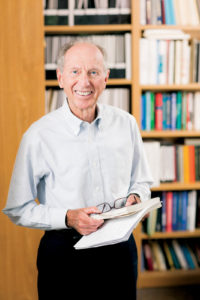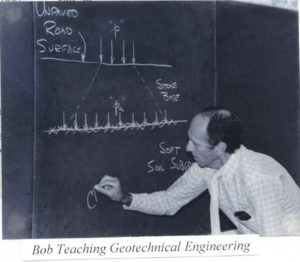
When Dr. Robert M. Koerner talks about geosynthetics, the cadence of his speech quickens and the passion behind his words suggests that geotextiles, geosynthetic clay liners, geomembranes and geogrids (to name a few) could quite possibly be the most exciting materials civil engineers have at their disposal. As a leader in the field of geosynthetics, Koerner has a list of accomplishments that is long and impressive—and he isn’t showing any signs of slowing down.
Koerner’s formal education culminated in 1968 with a Ph.D. in geotechnical engineering from Duke University in Durham, N.C., and shortly thereafter he began his career in the field on the faculty of civil, architectural and environmental engineering at Drexel University, Philadelphia, Pa. He was the founding director and is now director emeritus of the Geosynthetic Institute (GSI), as well as emeritus professor at Drexel. Among his many professional awards and achievements, he’s most proud of being a Distinguished Member of ASCE (American Society of Civil Engineers)—the highest honor the organization bestows—and an inductee into the prestigious National Academy of Engineering. In June 2016 Koerner added another achievement to the list when the Geosynthetic Materials Association (GMA) announced the biennial Dr. Robert Koerner Award and Lecture Series.
In the beginning, the book
For the first eight years of his teaching career, Koerner included geotechnical topics among the many other areas of civil, environmental and architectural engineering he taught—but it was far from being a specialty for him. Little did he know when an editor requested that he write a monograph on the topic of “construction fabric materials” in 1979, the course of his professional life was about to come into sharp focus on what would later become known as geosynthetics. “I said no thanks to the offer to write the book based on my perception that there was too little information available other than promotional,” Koerner says. “But shortly after, I got ahold of conference proceedings that took place in Paris the following year and there were indeed a lot of very intriguing papers and results of trials [on the topic] so I came back to the editor and said: ‘Yes, I’ll do it.’”
While the book, Construction and Geotechnical Engineering Using Synthetic Fabrics, ended up being a turning point for Koerner, he doesn’t consider it a rousing success in terms of the information it offered. “The timing of this little book was fortuitous, but in retrospect wasn’t very meaty,” he says. “However, after it was published, truly the phone never stopped ringing. The book was the only one of its kind out there at the time, and because of it people got to know about me and Drexel, and research and publications started coming [my way], and it was wonderful. I even got to the point within a couple of years where I was teaching geosynthetics courses, which I never could have envisioned in the beginning.”
Coining geo terms
At the time Koerner wrote his first book, the polymers now known as geosynthetics were simply known as construction fabric materials, and even that term wasn’t formalized. Koerner says civil engineer Dr. J.P.
Giroud coined the word “geotextiles,” and the term “geosynthetics” came from Joe Fluet Jr., P.E. The phrase “geosynthetic clay liners” is attributed to Koerner.
Although Koerner contributed to the current terminology, he wishes the field of geosynthetics was known instead as geopolymers. “I went along with geosynthetics even though I’d written a couple of papers by then using the term geopolymers,” he says. “I wish I’d stuck to my guns because in truth everything is a synthetic. Concrete is a synthetic. Steel is a synthetic. Really we’re in the polymer business.”
By the mid-1980s the terms were solidified and the field of geosynthetics was gaining steam. And despite his feelings about what he would like the field to be called, Koerner doesn’t dwell on what could have been. “I do wish our field today would have been geopolymers but, as they say, the horse done left the barn,” he says.
The good book
In 1984 Koerner wrote another book, Designing with Geosynthetics, which when compared to his first book he says is “the good one.” Now in its 6th edition, the 900-plus-page book has been published in four languages, with approximately 40,000 copies sold. What made the book better than the first one, he

says, is that it had terms like geotextiles, geogrids, geomembranes and geocomposites, by which he was able to organize the book. “And each edition includes more and more chapters devoted to unique things like geospacers, geofoam and geonets,” he says. “The book has been really good for the industry and by association for me, Drexel and [eventually] GSI.”
Two years later, Koerner founded GSI, a consortium of organizations with the mission to develop and transfer knowledge, assess and critique geosynthetics, and provide services to its members. “It was clear to me that this geosynthetics stuff was hot and I was still teaching as a full-time faculty member at Drexel and did not have enough time for the growing interest in geosynthetics,” he says. “The question was: Do I stay at university to continue what I was doing or do I create some kind of an institute? I chose a third option and created GSI within Drexel.”
These days one of Koerner’s sons, Dr. George Koerner, is the director of GSI and has taken over many of the responsibilities Bob Koerner had, including copious amounts of travel. “George is an expert in his own right,” Koerner says. “He has a doctoral degree in geotechnical engineering, the same as mine. He worked in industry, returned here in the latter part of the 80s and became director about four years ago. One of the ways you made sure someone stays with an organization is to make them the director, and you become emeritus. We have a nice division of duties.”
Virtual presence
Now Koerner’s duties include being an online instructor, sharing knowledge he’s gained in his more than 40 years in the industry. Last year alone he did 55 webinars, as well as several day-long courses on geosynthetics. And he still writes for a variety of publications, including Geosynthetics magazine. In the June issue, his article “We’re Losing the Battle” tackles a topic that’s at the core of his current industry concerns—that universities aren’t offering in-depth courses in geosynthetics. “There are so many engineering students graduating who could come into this field, but they don’t because they don’t know anything about it,” he says. “The universities are not equipped to do anything but basic kinds of courses.”
Koerner is doing his part to change that lack of university-level geosynthetic instruction. He put Designing with Geosynthetics in a series of 1,600 PowerPoint slides, each with a voice-over by him. “This will enable students to take an entire academic course in geosynthetics online,” he says. “We’ll now be offering this to universities around the world in the form of distance learning.”
The details of the course are still in the works and will likely vary from university to university, but Koerner’s preference is that professors would team-teach the course with him. Koerner would be available online as an expert resource, and the professor would handle managing the homework, quizzes and reporting to the university.
Road runner

The only thing Koerner does every day other than work in geosynthetics is run. The distance varies, but since 1972 running has been a part of his routine, and that includes running a number of marathons internationally. “I’m not a great runner. I am a middle-of-the-pack runner,” he says. “But I do some interesting thinking when I’m out on these long runs.”
Koerner likens the thinking he does when running to dreaming, especially on the long-distance runs. “Little vignettes come into your mind during an hour or an hour-and-a-half run,” he says. “The problem is you can’t think something all the way through. You have a vision for something and then another thought comes, so I do what a lot of people do with their dreams. When I get back from a run I write those thoughts down. And then during the day they might come to fruition or not.”
A family affair
If there’s one thing that trumps geosynthetics for Koerner, it’s his family, but there too, geosynthetics comes into play. He and his wife Paula have three children, each of whom is an engineer. Those three are now married and have two children each, and they are also all engineers or in school for engineering. It seemed a natural extension for Koerner and his wife to create a charity to support graduate students in engineering, so they created the Koerner Family Foundation (kffoundation.org) about 15 years ago.
And who is the person who has most influenced Koerner’s life? No contest. It’s his wife Paula. “She has been fundamental with every major decision I’ve made,” he says. “She has just been fantastic in every way. I love her dearly and respect her accordingly.”
Sigrid Tornquist, a writer and editor based in St. Paul, Minn., is a frequent contributor to IFAI publications.
 TEXTILES.ORG
TEXTILES.ORG


